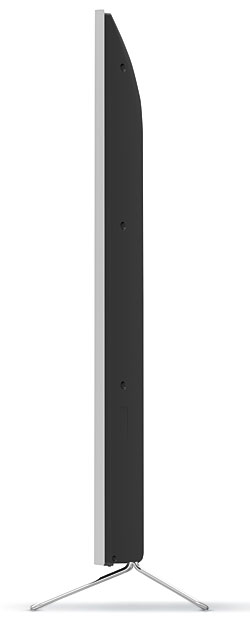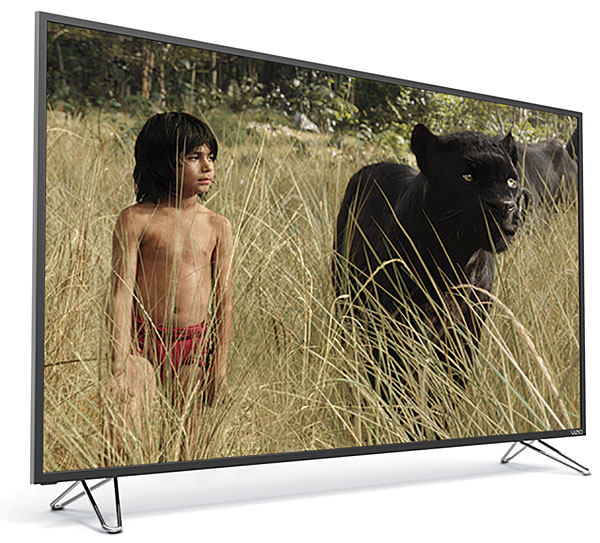Vizio M65-D0 Ultra HD Display Review Page 2
 Performance
Performance
In the opening sequence of The Revenant on 1080p Blu-ray, where hunters track a moose, the Vizio presented deep blacks and well-
defined shadow detail among trees in the heavily wooded forest. In a later shot where a Native American tribe attacks a fur-trapper encampment, highlights such as the setting sun on the water and trees engulfed in flames combined with the set’s strong blacks to deliver images with powerful contrast.
The Vizio’s accurate post-calibration color also contributed to its impressive picture quality. I watched an Ultra HD Netflix stream of Stranger Things, episode 7. In a scene where Steve chats with his friends outside a convenience store, the Vizio offered a subtle range of red hues, such as the maroon of his BMW, the garish red of a Coke can, and the red-orange trim of a varsity jacket. Meanwhile, the brown, yellow, and orange color scheme of the store came across with all its glum early-1980s aura intact, and skin tones of the squabbling friends also showed a good range of differentiation.
While the Vizio generally had good shadow detail in this episode, sequences in the Upside Down dimension, where El searches for Will, tested the limits of the set’s 64-zone local-dimming backlight. I could see a faint halo of light encircling El’s white-clad figure in the fully black netherworld. However, there were only a few other instances where I noticed such haloes, even in the case of movies with white-on-black film credits. For the most part, the M65-D0 exhibited very good picture uniformity, including when I viewed it off-axis.
 HDR Performance
HDR Performance
Vizio’s 2016 display lineup initially shipped with support for just the Dolby Vision HDR format, but a recent firmware update added support for HDR10, which is the format being used for current Ultra HD Blu-ray releases. Taking advantage of this, I loaded The Martian into Samsung’s UBD-K8500 Ultra HD Blu-ray player.
In a scene where stranded astronaut Mark Watney retrieves “organic matter” to fuel his farming experiments, sun reflections on the nearby solar panels had a brilliant look that really helped the image to pop. When I watched the same sequence on regular Blu-ray, the reflections came across as less intense. Scanning forward to a scene in a NASA control room where a technician first discovers that Watney is alive, I experienced a similar result: Highlights such as the banks of display panels had a punchier, more brilliant look on the HDR10 ver- sion, while the deeper, more detailed shadows helped to flesh out the image.
Next, I checked out Man of Steel on both Blu-ray and Dolby Vision UHD (streamed from Vudu). In a scene where the Earth father of young Clark Kent shows him the ship that transported him from space, beams from flashlights and glints of sun cutting through slats in the barn looked powerfully bright via Dolby Vision, while the barn’s shadowy interior came across as a deep tone of black. Comparing the same scene with its Blu-ray version, the latter looked considerably less dynamic. However, I did note a few banding artifacts in the Dolby Vision streams of both Man of Steel and Mad Max: Fury Road. A streaming issue, or an artifact generated by the Vizio display? At this point, with no access yet to Dolby Vision content on Ultra HD Blu-ray, it’s impossible to say.

Conclusion
Future-savvy or future shock? With the M65-D0, I experienced a bit of both. While I can appreciate the statement that Vizio has made by eliminating the digital tuner and turning the focus to streaming, I was more impressed by the set’s picture quality. The M65-D0 delivered deep blacks, very good shadow detail, and excellent contrast, especially when in HDR mode. With a careful calibration, it was also capable of rendering accurate Rec. 709 color.
What I didn’t appreciate about the M65-D0 was its single HDMI 2.0a input and the sometimes-spotty Wi-Fi performance of its Android tablet remote control. Also, when you consider the Vizio’s lack of extended color gamut capability and somewhat limited peak light output, you realize that its HDR performance isn’t as mind-blowing as what you can expect from higher-end models, including Vizio’s own P series and Reference series. That said, I liked what I saw with the M65-D0, and I definitely like its price.






















































